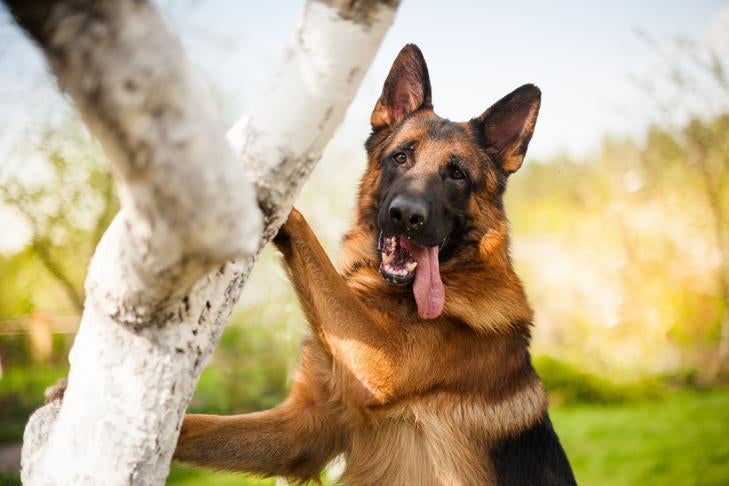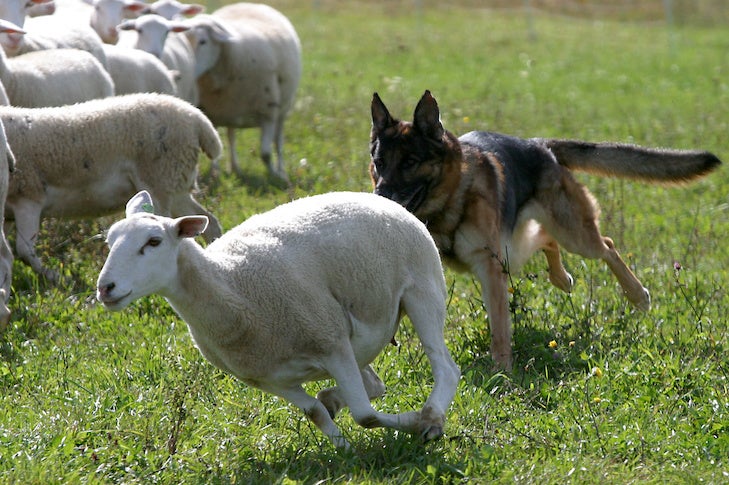
Is a German Shepherd Dog right for you? Experts who know the breed will tell you that it all depends. Perhaps a better answer to the question “Which dog is right for you?” lies in a few bigger questions. What do you want in a dog? Where do you plan to take your dog? Gow much time (and money) do you have for a dog? What is your lifestyle?
People often choose a puppy because it is cute and they are attracted to it. Maybe they see the breed on TV or in a movie. Later, they learn that their little pup is no longer a few pounds, but a 60- to 80-pound adult with lots of energy and a constant desire to play. The truth is that not all larger dog breeds do well in apartments or with laid-back families. How well a dog adjusts to their new environment depends on the dog, their training, and their function.

So the first part of the answer begins by asking yourself about your lifestyle, the size of your living quarters, and the amount of time you are willing to spend with your dog. There are over 60 breeds in the Herding, Working, and Sporting Groups, and they were all developed to be athletes and capable of a lot of work. That means you should expect the German Shepherd Dog to have a lot of energy and a place where the dog can use it.
The German Shepherd Dog was developed to have a unique work ethic, which made it attractive to governments and the public. To fully understand the breed and its work ethic, let’s begin with an understanding of some history and background of the German Shepherd Dog. Having some breed knowledge helps to put many of these questions into perspective.
Getting to Know the German Shepherd Dog Breed
In the late 1800s, Max Emil Friedrich von Stephanitz, while studying at the Berlin Veterinary School, became interested in the herding dogs that were being used throughout Germany. But instead of pursuing a career in veterinary medicine or his dream as a gentleman farmer, he relented to family pressure and joined the military.
As a cavalry officer in the German countryside, von Stephanitz came to admire the sheep-herding dogs he encountered. He noticed their keen intelligence and lightning-fast responsiveness as well as their special abilities to herd sheep. In Germany, flocks of sheep are moved from their pens to open areas along the road where they can pasture.
The dog’s job is to keep the sheep on the grassy roadside, away from fast-moving cars and out of a farmer’s crops. This kind of sheep herding is very demanding and is called “tending” or “boundary” herding. The AKC offers a sport called Herding “C” course. It mirrors this kind of boundary work or, as some call it, the invisible fence.

Traveling with the German military allowed von Stephanitz to continue his keen interest in herding dogs and he quickly came to the conclusion that he could breed a better herding dog. To do this, he began by expanding his knowledge. He talked with breeders and attended some of the country’s largest dog shows.
In April 1899, his friend Arturo Meyer accompanied him to a show, where they spotted a dog named Hektor Linksrhein. He was a four-year-old with a striking, wolf-like appearance. His intelligence and depth of character sealed the deal, and they paid over 200 German gold marks to purchase the dog. With this first dog, von Stephanitz set out to develop the ultimate farm dog. He began to breed German sheepdogs on his sprawling estate.
His first efforts were to place emphasis on standardizing the many German “flavors” of herding dogs that were identifiable as sheepdogs. In the beginning, how they looked was of little importance. His emphasis remained on fixing the traits he considered central to producing the ultimate German herding farm dog. Because the herding instinct and their working ability were not the issues, he focused on the upright ears and wolf-like body style that so many fanciers admired.
He preferred a smaller and stockier type. Many had wiry coats and curled tails. Some needed better temperaments. von Stephanitz crossed dogs from Wurttemberg in south Germany, which were generally larger and heavier-boned with more tractability. Eventually, he found the middle ground he sought. Working ability and soundness were first, followed by appearance. Today, when German Shepherds are judged at dog shows, each submits to a quick temperament test by the judge, to ensure it has a stable temperament.
“Never idle, always on the go, well-disposed to harmless people, but no cringer, good with children and always in love” were the words von Stephanitz used to describe his new breed.
Work Ethic That’s Unique to the German Shepherd Dog
From the very beginning, a keen emphasis was placed on the unique character, trainability, and protective instincts found in these herding dogs. Their dependability and their special herding traits became legendary. Over time, the breed began to be used for many other services. When blind Morris Frank returned from Switzerland in 1929 with his German Shepherd Dog “Buddy,” he opened the door for German Shepherd Dogs to be used as guide dogs for the blind.
In a very short period of time, the breed would be associated with programs for the blind and for services involving many other disabilities. Their intelligence, trainability, and desire to work put German Shepherd Dog at the top of many lists. Some breeders began their own lines for temperament, as opposed to conformation and physical appearance. It was not long before breeding programs throughout America began to selectively breed for service dog programs as their ultimate goal.
Owners of German Shepherds Have a Lot to Say
Most owners characterize their German Shepherd Dog by saying they purchased it because the dog was vibrant, irrepressible, high-energy, and strong. Alertness and attentiveness are often offered as some of the most popular reasons to own one.
Mary Jane says that she loves her male German Shepherd because “he is always close to her children and will position himself about 30-40 feet away from them and watches to oversee their play.” John, who works from home, says, “I loved my dog because she always knows where I am and I can depend on her.”
Nancy lives alone in an area with lots of construction workers. She taught her German Shepherd both English and German commands. She uses one-syllable English and German commands when strangers are around. She says, “I can tell him in English or German to ‘sit’ or ‘down.’ He understands both languages.” She adds, “He will stay there with his alert ears straight up, staring at everyone. I love him because he makes me feel safe.”

The breed’s early history also helped shape the GSD’s image. It began with the German army in World War I when the country saw the need for a German military dog. Because the German Shepherd Dog showed no fear on the battlefield, they carried medical supplies and bullets and served as sentries. This made this breed especially effective during daytime and nighttime battles.
It wasn’t long before the German army and others came to appreciate the value of this war dog. Other countries also noticed the GSD’s value, which successfully helped to promote the breed and its value worldwide. Unfortunately, sentiment about the Germans in the United States and elsewhere turned, and in 1918, the German Shepherd Dog was renamed the Shepherd Dog in the U.S. The British responded in kind, renaming the breed the Alsatian.
Things changed again, and after the war, the breed’s reputation as a war dog spread. The entertainment industry joined in and created canine film stars such as Rin-Tin-Tin and Strong Heart. The breed suddenly enjoyed skyrocketing popularity.
Is a German Shepherd Dog Right for You?
History and 100 years of experience proved that the German Shepherd Dog is a hard worker that makes a loyal family pet and guardian.
German Shepherd Dog owners should be prepared for an energetic dog that needs a job. Even if your GSD will be a pet, they were bred to work and will need an outlet for their energy and drive. Keep in mind that you will need to provide your dog with extensive physical and mental exercise every day.
Do you have the time and energy to properly socialize and train your GSD? Do you have a steady income if any health issues arise? Do you have enough space for this large breed to flourish? Ask yourself these questions before getting a German Shepherd Dog.
Once you decide to look for a GSD puppy of your own, AKC Marketplace can connect you with a responsible breeder. Your breeder should ask you questions about your lifestyle and answer your questions about the breed. If both you and the breeder are sure the German Shepherd Dog is right for you, enjoy an action-packed life with your new best friend!
At AKC Marketplace, we can help you find your dream dog. You can find AKC-registerable puppies from responsible, passionate breeders, and we provide the tools you need for every step of the process. Visit marketplace.akc.org to start connecting with dog breeders in your area!

